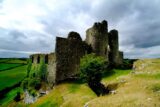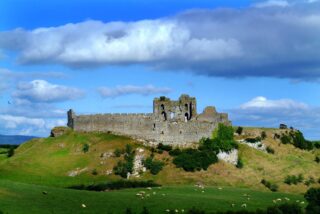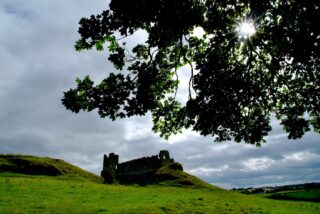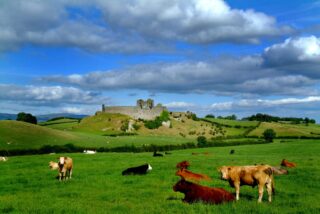Notice
Castleroche is a National Monument in state guardianship
*External Viewing Only due to ongoing works on the interior of the castle*
WARNING: It should be noted that these sites are unguided and a level of care and caution should be maintained during all stages of your visit. The Office Of Public Works (OPW) will not be held responsible for any damages, injuries, or losses that occur
Castleroche Castle
Located 7.3 kilometres (4.5 miles) north-west of the town of Dundalk, in the townland of Roche, the 13th century Castle Roche is dramatically perched on a high rocky limestone promontory, affording sweeping views of the surrounding countryside in all directions, including portions of South Armagh generally known as The Fews. The townland and the castle derive their names from the French word "roche" meaning rock. Early records name Castle Roche as Castellum de Rupe or Castle on the Rock. Its lofty position gives it a fairy-tale quality and it was the first castle in Ireland known to have been built by a woman. It is recorded as marking the northernmost boundary of The Pale, the English geographic sphere of influence in Ireland in the late Middle Ages.
Hailing from Alton Castle in Staffordshire, Bertram de Verdun arrived in April 1185, as part of King John’s first expedition to Ireland. Most histories of the castle state that it was built in 1236 by Bertram's granddaughter, Lady Rohesia (aka Roesia and Rose) de Verdun (1204-1247), the only daughter and heir of Nicholas de Verdun (c.1169-1231) and his second wife, Clementia le Boteler. Rohesia was the second wife and widow of Theobald de Botiller (1200-1230), second chief Butler of Ireland, whom she had unwillingly married on the 4th September 1225 at the personal request of King Henry III. For reasons of inheritance, her own children adopted her maiden name instead of their father’s. The castle was most likely completed by her son John de Verdun.
Subsequent to her husband’s sudden and early death in France in 1230, Lady Rohesia moved her household to her lands in Ireland. Legend holds that she promised her hand in marriage to any man who could design a castle to her liking. One suitor passed the test and the castle was subsequently built. On their wedding night, she invited her husband to take in the view of his new lands and possessions from their bedroom window, through which she then pushed him to his death on the ground far below. Fanciful reports suggest that his ghost still haunts the castle. Later in her life, around 1240, and as a reflection of her piety, Lady Rohesia founded the Augustinian Grace Dieu priory in Leicestershire England, which she entered as a nun in 1242. She died there in 1247 and was buried in nearby Belton parish church, where her tomb, and its beautifully carved effigy, can still be seen.
Castle Roche’s various structures were erected so as to enclose the entire summit of the high rocky mound. Surrounded by rock-cut ditches, the ramparts enclose an area of an irregular triangular or semi-circular form. One of its formidable curtain walls, which forms the longest span, is just under 72 metres (80 yards) in length, the other being about 37 metres (40 yards). At the northern end of this wall was a D-shaped tower. The oldest part of the complex is located at the southern end where there are the ruins of a keep, the outer halves of two once-circular towers with their defensive arrow-slits, and a proportionately small, arched sallyport. This latter construction has been identified as a true gate house, where the gate is placed between two towers without any supporting building behind. The two four-storeyed towers originally had a barrel vault over the ground floor level. It has also been suggested that a drawbridge once existed and an engraving from 1846 shows that there was a deep gully dug in front of the towers and the gate, which is now filled in.
Of the castle’s battlements, the parapets that run inside the full length of the curtain walls are plainly crenelated, of which almost all include one arrow-slit. To the south of the gate house is a rectangular residential building, on the first floor of which are the remains of a large hall with three fine windows and incorporated window seats. At the south end of the east-facing gable wall is a passage that accesses four tall arrow-slits that defend the approach to the entrance gate. In the centre of the enclosure are the remains of what might have been a square tower or the covering of a well.
In one of the many attempts to conquer the Irish chieftain Shane O’Neill (1530-1567), an order, set out in the Patent Rolls in the third year of Queen Elizabeth’s reign, called upon the Sheriff of Dublin, and those other sheriffs of the counties of the Pale, to assemble all the English forces in Ireland for a hosting or gathering at Castle Roche on the 1st July 1561. Those summoned included "all lords spiritual and temporal, knights, gentlemen, freeholders and also mayors, bailiffs, sovereigns, provosts and governors of cities and market towns, and also all others who were wont to be sent by ecclesiastics to such a hosting…." They were to bring with them arms with sufficient victuals to serve for six weeks, and also one wagon sufficiently equipped with two men, with axe, reaping-hook, and spade…."
Richard Bellew obtained a grant to repair the castle in 1642 and early on in 1649, the year of his execution, the castle was defended in the name of King Charles I. It was subsequently demolished by the soldiers of Oliver Cromwell’s army.
Protect our Past - Click here to read about the importance of protecting our country’s unique heritage sites
This national monument is protected in accordance with the National Monuments Acts 1930 to 2014
Gallery
Nearby sites to visit
Carlingford Castle
A Norman citadel in the shadow of a giant
Approx. 19.2 km from Castleroche Castle
Old Mellifont Cistercian Abbey Monastic Site
Visit Ireland’s very first Cistercian foundation
Approx. 33.6 km from Castleroche Castle
Battle of the Boyne Visitor Centre – Oldbridge Estate
Where two kings fought for Europe’s future
Approx. 36.0 km from Castleroche Castle
Brú na Bóinne Visitor Centre: Newgrange, Knowth and Dowth
Step into Ireland’s richest archaeological landscape
Approx. 39.1 km from Castleroche Castle
Hill of Tara
Experience the legacy of the high kings
Approx. 52.5 km from Castleroche Castle
Loughcrew Megalithic Cemetery
A high point of Neolithic art and design
Approx. 53.2 km from Castleroche Castle




